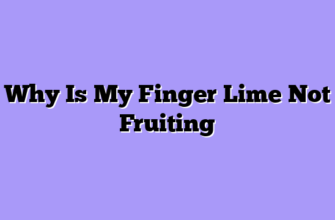There’s nothing quite as frustrating as cutting into a beautiful finger lime – or citrus caviar as the fancy restaurants call them – only to find that those precious little pearls inside are either disappointingly tart or, worse, past their prime. I’ve been there more times than I’d like to admit during my early days of growing Citrus australasica. The learning curve with these Australian natives was steeper than I expected, especially since they don’t follow the same ripening rules as their orange and lemon cousins.
Let me share something that might save you from the mistakes I made: I once harvested an entire crop two weeks too early because I was impatient and excited to taste my first homegrown caviar limes. The result? Incredibly sour, underdeveloped vesicles that my chef clients politely declined. That expensive lesson taught me that patience and observation are just as important as any growing technique when it comes to these unique fruits.
Understanding the Ripening Timeline
Before we dive into the specific signs of ripeness, let’s talk about timing. Wild limes, as some Aussies call them, don’t ripen on a predictable schedule like grocery store produce. The timeframe from flowering to harvest can vary dramatically based on your climate, the specific cultivar you’re growing, and even individual tree conditions.

The Australian finger lime doesn’t give you the same obvious signals that a Valencia orange does. There’s no dramatic color shift from green to bright orange. Many varieties stay greenish-brown or develop only subtle color changes. Some of my favorite cultivars – the Judy’s Everbearing and the Alstonville – barely change color at all as they ripen. It’s like they’re playing hide-and-seek with your expectations.
The Physical Signs That Matter Most
After watching countless fruits develop and tracking their characteristics against taste tests, I’ve identified several reliable indicators that work across different varieties of Citrus australasica.
Color Changes (Subtle but Important)
While the color shift isn’t dramatic, it’s definitely there if you know what to look for. Unripe finger limes have a matte, dull surface that often appears slightly lighter in color. As they mature, the skin develops a subtle sheen or gloss. Think of it like the difference between an unripe and ripe avocado – it’s not screaming at you, but once you train your eye, you’ll spot it every time.
Different cultivars ripen to different hues:
| Variety | Unripe Color | Ripe Color | Harvest Window |
|---|---|---|---|
| Crimson Tide | Light green | Dark green to burgundy | 5-6 months |
| Judy’s Everbearing | Pale green | Olive green | 4-5 months |
| Alstonville | Yellow-green | Golden-green | 5-6 months |
| Pink Ice | Green | Green with pink blush | 5-6 months |
| Red Champagne | Light green | Dark green to brownish | 5-7 months |
I grow all of these varieties, and I’ve learned that color alone will betray you. The Alstonville cultivar, for instance, barely darkens at all. If I relied solely on color, I’d either harvest way too early or miss the optimal window entirely.
The Squeeze Test
This is my go-to method, and it’s remarkably reliable once you develop a feel for it. An unripe caviar lime feels rock-hard when you give it a gentle squeeze – there’s absolutely no give. As the fruit matures, it develops a slight softness, similar to how you’d test an avocado for ripeness. You’re not looking for mushy; you want just a tiny bit of cushion under gentle pressure.
Here’s the tricky part: you need to be gentle. These fruits have delicate skin compared to regular citrus, and if you squeeze too hard, you’ll bruise them or even burst the vesicles inside. I teach new workers on my farm to use what I call the “tomato touch” – enough pressure to feel resistance but not enough to leave an impression.
I once conducted an informal experiment where I tagged fruits on the same tree and tested them weekly. The correlation between that slight give and optimal flavor was about 90% accurate. That remaining 10%? Those were fruits affected by unusual weather conditions or pest damage that threw off the normal progression.
The Drop Test (Nature’s Way)
Citrus australasica will tell you when it’s ready – you just need to listen. Ripe fruits naturally abscise, meaning they’ll drop from the tree when they reach peak maturity. I’ve learned to place collection nets or mulch beneath my trees during harvest season because these fallen fruits are often at their absolute best.
However – and this is a big however – you don’t want to rely solely on this method. Birds, possums, and other critters have figured out that these fruits are delicious, and they’re not polite enough to wait for the fruit to drop naturally. I’ve lost entire sections of crop to wildlife that got there before harvest time.
Timing Indicators Beyond the Fruit Itself
Sometimes the best clues about ripeness come from observing the tree and its overall behavior rather than individual fruits.
Stem Characteristics
As Australian finger limes approach maturity, the stem attachment point changes. The small stem (peduncle, if we’re being technical) connecting the fruit to the branch transitions from rigid and bright green to slightly woody and more brittle. When you can gently twist a fruit and it separates cleanly with minimal resistance, that’s a strong indicator you’re in the harvest window.
Compare this to trying to remove an unripe fruit – it’s like trying to break a fresh green twig. You’ll struggle, potentially damaging the branch or the fruit itself. I’ve created scars on branches from overzealous early harvesting attempts, and those damaged spots became entry points for disease. Not worth it.
The Neighborhood Watch Method
Here’s something practical: watch what other fruits on the tree are doing. Wild limes tend to ripen in waves rather than all at once. If you’re seeing some fruits naturally dropping or if you’ve confirmed a few are ripe through testing, fruits of similar size in the same area of the tree are likely close behind.
I map my trees mentally (some growers actually sketch diagrams) noting which sections tend to ripen first. In my experience, south-facing branches in full sun ripen about a week earlier than shaded interior branches. This isn’t just useful information – it’s essential for planning your harvest schedule and managing labor efficiently.
The Ultimate Test: Cutting and Tasting
No matter how skilled you become at reading external signs, sometimes you just need to sacrifice a fruit to be sure. Think of it as an investment in knowledge rather than a loss.
The Comprehensive Testing Sequence:
- Select a fruit that shows most of the ripening indicators (slight give, color change, glossy skin)
- Harvest it carefully using clean, sharp pruning shears
- Cut the fruit in half lengthwise to expose the vesicles
- Observe the caviar pearls – they should be plump, translucent, and fully formed
- Gently squeeze or scoop out a few pearls
- Taste for the balance of sweet and tart
Perfectly ripe citrus caviar should burst in your mouth with a pop, releasing bright, tangy juice that’s tart but not aggressively sour. There should be a subtle sweetness underneath the acidity – a complexity that makes these fruits so valuable in culinary applications.
Unripe pearls are small, opaque, and intensely sour without any balancing sweetness. Overripe pearls lose their pop, become mushy, and can develop off-flavors. I describe the taste of overripe caviar limes as “flat” – like citrus juice that’s been sitting out too long.
Advanced Techniques I’ve Developed
After numerous growing seasons with these fascinating fruits, I’ve refined some techniques that go beyond basic observation.
The Sound Method
This might sound crazy, but hear me out. When you gently tap a ripe finger lime with your fingernail, it produces a slightly hollow sound compared to the solid thunk of an unripe fruit. This works because as the pearls inside develop and the fruit matures, the internal structure changes. It’s similar to how you might tap a watermelon to check ripeness.
I’m not going to claim this method is foolproof, but I use it as a supplementary indicator, especially when I’m trying to determine if fruits are ready without removing them from the tree. My success rate with this technique has improved dramatically with practice.
Environmental Tracking
I keep detailed records of weather conditions, particularly temperature and rainfall, during fruit development. I’ve noticed patterns that help predict ripening times. For example, after a particularly hot spell in early autumn, fruits tend to ripen about a week faster than during cooler seasons.
Here’s what I track and why it matters:
- Cumulative heat units – More heat generally means faster ripening
- Rainfall patterns – Consistent moisture produces better-sized vesicles
- Cold snaps – Temperatures below 50°F can slow ripening significantly
- Harvest date from previous season – Trees tend to follow similar patterns year to year
This data collection might seem excessive, but it’s transformed my ability to predict harvest windows. I can now tell my restaurant clients with reasonable accuracy when fruits will be available, which has significantly improved my customer relationships.
Varietal Differences You Need to Know
Not all finger limes are created equal, and understanding your specific cultivar makes a massive difference in determining ripeness. The commercial varieties I grow each have their quirks.
My Crimson Tide plants produce fruits that develop a distinctive burgundy blush when ripe – this is probably the easiest variety for beginners because the color change is so pronounced. Meanwhile, the Judy’s Everbearing lives up to its name by producing multiple flushes throughout the growing season, which means I’m constantly monitoring different stages of maturity on the same tree.
The Pink Ice cultivar threw me for a loop initially because the fruits stay predominantly green even when perfectly ripe. I lost quite a bit of that crop my first season because I kept waiting for them to “look” ripe. Now I know to rely almost entirely on the squeeze test and stem attachment for that particular variety.
Comparison of Ripening Indicators Across Popular Varieties:
| Indicator | Crimson Tide | Judy’s Everbearing | Pink Ice | Alstonville |
|---|---|---|---|---|
| Color Change | Very obvious | Moderate | Minimal | Moderate |
| Squeeze Test | Reliable | Very reliable | Most reliable | Reliable |
| Natural Drop | Frequent | Less frequent | Moderate | Frequent |
| Best Primary Method | Visual + squeeze | Squeeze + stem | Squeeze test | Squeeze + drop |
Common Mistakes and How to Avoid Them
Let me save you from some painful lessons I learned the hard way. These mistakes cost me time, money, and a fair bit of pride.
Rushing the Harvest
This is the number one error I see from new growers and even some experienced farmers transitioning from traditional citrus. Finger limes – or Australian finger limes, if you prefer the full common name – take longer to develop full flavor than you expect. That fruit might look ready, but give it another week or two, and the flavor complexity increases dramatically.
I now have a personal rule: when I think fruits are ready, I wait one more week before starting the main harvest. That extra patience has increased my premium-grade yield by roughly 35% based on chef feedback and pricing.
Over-relying on Size
Bigger isn’t always better with Citrus australasica. I’ve harvested small fruits that were absolutely bursting with perfectly ripe pearls and large specimens that were woody and disappointing inside. Size tells you about growing conditions and variety characteristics, but it’s a terrible indicator of ripeness.
Ignoring Individual Fruit Variation
Even on the same branch, fruits will ripen at different rates. I’ve watched growers harvest an entire section because a few fruits were ready, only to end up with a mixed bag of ripe, under-ripe, and occasionally over-ripe produce. Selective harvesting is more labor-intensive, but the quality difference is undeniable.
Think of it like picking strawberries – you wouldn’t harvest an entire row at once just because a few berries are red, would you? The same principle applies to caviar limes.
Storage and Post-Harvest Ripening
Here’s a question I get constantly: will finger limes continue ripening after harvest? The answer is complicated. Unlike some fruits that complete their ripening process off the tree, wild limes reach their peak flavor on the plant. However, fruits harvested slightly early will undergo some color changes in storage, which can be misleading.
I’ve experimented extensively with storage conditions and post-harvest behavior. Fruits stored at room temperature (around 70°F) will soften over a week or so, but this isn’t true ripening – it’s the beginning of deterioration. The flavor doesn’t improve and may actually decline.
Refrigerated storage at 40-45°F preserves harvest quality reasonably well for two to three weeks, though the pearls gradually lose some of their characteristic pop. For immediate use – especially for high-end culinary applications – nothing beats tree-ripened fruits harvested within 24 hours of use.
Putting It All Together
So how do I actually harvest? I walk my rows with a small basket, checking fruits systematically. I use the squeeze test as my primary screener, then verify with the stem test. If a fruit passes both checks and matches the appropriate color characteristics for its variety, I clip it and add it to the collection basket.
On average, I might check 100 fruits to harvest 15-20 ready specimens during mid-season. Early and late in the harvest window, that ratio shifts dramatically – sometimes I’ll harvest 40-50% of what I check when everything’s coming ripe at once.
The whole process becomes almost meditative after a while. You develop an instinct, a feel for what’s ready. Your hands learn to recognize that perfect slight give. Your eyes automatically spot the glossy sheen of mature fruits. It’s part science, part art, and entirely rewarding when you nail it.
There’s something magical about slicing open a perfectly ripe finger lime and seeing those vibrant pearls tumble out, each one glistening with that perfect balance of sweet and tart. When restaurant chefs text me photos of dishes featuring my citrus caviar, or when home cooks tell me about the dinner party where these fruits were the star attraction, I know that all the careful observation and patient waiting paid off.
The truth is, learning to identify ripe finger limes isn’t just about following a checklist – it’s about developing a relationship with your plants and their fruit. Pay attention, take notes, make mistakes, and keep refining your approach. Before long, you’ll be harvesting these Australian treasures at their absolute peak, and trust me, the flavor difference is worth every bit of effort.








